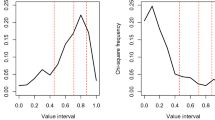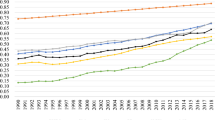Abstract
High-quality economic development (HQED) in China is an important embodiment for adapting new normal of economy and implementing new concept of sustainable development. Accurately portraying the evolution trajectory of China’s HQED and tracing sources of its spatial–temporal disparities are of great significance for promoting balanced and healthy economic development. Since the evolution of HQED is dynamic and motivated by the need for continuously monitoring the time-varying process of HQED, we develop a functional high-quality economic development index (HQEDI(t)) in the context of functional data analysis. We use the functional ANOVA to examine the significance of disparities between regions, in terms of static absolute level and dynamic development potentials, based on the continuous measurement of provincial HQED. The extended functional Dagum Gini coefficient is also used to decompose the overall and structural inequality of China’s HQED. The results show the following. (1) The overall level of China’s HQED has been steadily increasing, and innovation efficiency is the leading factor for improvement of China’s HQED. (2) Uneven development between regions exists only at the absolute level and grow velocity of HQED, but it is not significant in acceleration. (3) The overall regional disparities of China’s HQED show a downward trend, and inter-regional disparities dominate the inequality of HQED. We make a contribution to the idea of a dynamic framework for evaluating HQED and provide guidance for policy-making authorities to formulate target development policies.









Similar content being viewed by others
Data availability
The datasets generated or analyzed during the current study are available from the corresponding author on reasonable request.
References
Abbass, K., Qasim, M. Z., Song, H. M., Murshed, M., Mahmood, H., & Younis, I. (2022). A review of the global climate change impacts, adaptation and sustainable mitigation measures. Journal of Environmental Science and Pollution Research, 29, 42539–42559. https://doi.org/10.1007/s11356-022-19718-6
Amjad, A., Abbass, K., Hussain, Y., Khan, F., & Sadiq, S. (2022). Effects of the green supply chain management practices on firm performance and sustainable development. Journal of Environmental Science and Pollution Research, 29, 66622–66639. https://doi.org/10.1007/s11356-022-19954-w
Awan, U., Gölgeci, I., Makhmadshoev, D., & Mishra, N. (2022). Industry 4.0 and circular economy in an era of global value chains: What have we learned and what is still to be explored? Journal of Cleaner Production, 371, 133621. https://doi.org/10.1016/j.jclepro.2022.133621
Chen, J. H., Chen, Y., & Chen, M. M. (2020a). China’s high-quality economic development level, regional differences and dynamic evolution of distribution. The Journal of Quantitative & Technical Economics, 37(12), 108–126.
Chen, M. H., Liu, Y. X., Liu, W. F., & Wang, S. (2020b). Measurement, source decomposition and formation mechanism of regional differences in China’s urban livelihood development. Statistical Research, 37(05), 54–67.
Dagum, C. (1997). A new approach to the decomposition of the gini income inequality ratio. Empirical Economics, 22(4), 515–531. https://doi.org/10.1007/BF01205777
Dai, F., Liu, H., Zhang, X., & Li, Q. (2022). Does the equalization of public services effect regional disparities in the ratio of investment to consumption? Evidence from provincial level in China. SAGE Open. https://doi.org/10.1177/21582440221085007
Deng, X. J., & Zhang, L. (2022). Spatio-temporal disparity of water use efficiency and its influencing factors in energy production in China. Ecological Informatics, 71, 101779. https://doi.org/10.1016/j.ecoinf.2022.101779
Fang, R. N., Lv, Y. F., & Cui, X. H. (2021). Measurement and comparison of high-quality development of China’s eight comprehensive economic zones. Inquiry into Economic Issues, 02, 111–120.
Graven, P., & Wahba, G. (1979). Smoothing noisy data with spline function: Estimating the correct degree of smoothing by the method of generalized cross-validaton. Journal of Numerical Mathematics, 31, 377–403. https://doi.org/10.1007/BF01404567
Guo, Y., Fan, B. N., & Long, J. (2020). Practical evaluation of china’s regional high-quality development and its spatiotemporal evolution characteristics. The Journal of Quantitative & Technical Economics, 37(10), 118–132.
Hickel, J. (2019). The sustainable development index: Measuring the ecological efficiency of human development in the anthropocene. Ecological Economics., 167, 1–10. https://doi.org/10.1016/j.ecolecon.2019.05.011
Huang, Y. M., Haseeb, M., Usman, M., & Ozturk, I. (2022). Dynamic association between ICT, renewable energy, economic complexity and ecological footprint: Is there any difference between E-7(developing) and G-7 (developed) countries? Technology in Society., 68, 101853. https://doi.org/10.1016/j.techsoc.2021.101853
Jiang, L., Zuo, Q. T., Ma, J. X., & Zhang, Z. Z. (2021). Evaluation and prediction of the level of high-quality development: A case study of the Yellow River Basin China. Ecological Indicators, 129, 107994. https://doi.org/10.1016/j.ecolind.2021.107994
Li, B., Yang, G., & Wan, R. (2017). Dynamic water quality evaluation based on fuzzy matter-element model and functional data analysis, a case study in Poyang Lake. Environmental Science and Pollution Research, 24(7), 1–11. https://doi.org/10.1007/s11356-017-9371-0
Li, T., Wang, Y., & Zhao, D. (2016). Environmental Kuznets Curve in China: New evidence from dynamic panel analysis. Energy Policy, 91, 138–147. https://doi.org/10.1016/j.enpol.2016.01.002
Li, Y., & Lei, H. (2021). Research on regional differences and convergence of China’s local government’s tax efforts. The Journal of Quantitative & Technical Economics, 38(04), 63–82. https://doi.org/10.4028/www.scientific.net/AMR.347-353.3952
Liu, Y., Liu, M., Wang, G., Zhao, L. L., & An, P. (2021). Effect of environmental regulation on high-quality economic development in China-an empirical analysis based on dynamic spatial durbin model. Environmental Science and Pollution Research, 28(39), 1–18. https://doi.org/10.1007/s11356-021-13780-2
Long, X., & Ji, X. (2019). Economic growth quality, environmental sustainability, and social welfare in China -provincial assessment based on genuine progress indicator (GPI). Ecological Economics, 159, 157–176. https://doi.org/10.1016/j.ecolecon.2019.01.002
Lu, W., Wu, H., & Wang, L. (2022). The optimal environmental regulation policy combination for high-quality economic development based on spatial durbin and threshold regression models. Environment, Development and Sustainability. https://doi.org/10.1007/s10668-022-02372-w
Lv, C. C., & Cui, Y. (2020). Research on regional gap and time space convergence of China’s high-quality development. The Journal of Quantitative & Technical Economics, 37(09), 62–79.
Ma, R., Luo, H., Wang, H. W., & Wang, T. C. (2019). Study of evaluating high-quality economic development in Chinese regions. China Soft Science, 2019(07), 60–67.
Nie, C. F., & Jian, X. F. (2020). Measurement of China’s high-quality development and analysis of provincial status. The Journal of Quantitative & Technical Economics, 37(02), 26–47.
Qu, X. E., & Liu, L. (2021). The impact of environmental decentralization on high-quality economic development. Statistical Research, 38(03), 16–29. https://doi.org/10.19343/j.cnki.11-1302/c.2021.03.002
Quan, H. (2018). Navigating China’s economic development in the new era: from high-speed to high-quality growth. China Quarterly of International Strategic Studies, 4(2), 1–16. https://doi.org/10.1142/S2377740018500161
Ramsay, J. O., & Silverman, B. W. (2005). Functional data analysis. M. Springer.
Reimherr, M., & Nicolae, D. (2014). A functional data analysis approach for genetic association studies. Annals of Applied Statistics, 8(1), 406–429. https://doi.org/10.1214/13-AOAS692
Ren, B. P., & Li, Y. M. (2018). The construction and transformation path of China’s high-quality development evaluation system in the new era. Journal of Shaanxi Normal University: Philosophy and Social Sciences Edition, 47(3), 105–113.
Rodriguez, P. A., & Ezcurra, R. (2010). Does decentralization matter for regional disparities? A cross-country analysis. Journal of Economic Geography, 10(5), 619–644.
Ruiz-Medina, M. D., Espejo, R. M., Ugarte, M. D., & Militino, A. F. (2014). Functional time series analysis of spatio-temporal epidemiological data. Stochastic Environmental Research and Risk Assessment, 28(4), 943–954. https://doi.org/10.1007/s00477-013-0794-y
Shang, H. L. (2017). Forecasting intraday S&P 500 index returns: A functional time series approach. Journal of Forecasting, 36(5), 741–755. https://doi.org/10.1002/for.2467
Sun, Y., Ding, W., & Yang, Z. (2020). Measuring China’s regional inclusive green growth. The Science of the Total Environment., 713, 136367. https://doi.org/10.1016/j.scitotenv.2019.136367
Tang, D. C., Li, Z. J., & Bethel, B. J. (2019). Relevance analysis of sustainable development of China’s Yangtze River economic belt based on spatial structure. International Journal of Environmental Research and Public Health, 16(17), 3076. https://doi.org/10.3390/ijerph16173076
Tian, Y., & Sun, C. W. (2018). Comprehensive carrying capacity, economic growth and the sustainable development of urban areas: A case study of the Yangtze River Economic Belt. Journal of Cleaner Production, 195, 486–496. https://doi.org/10.1016/j.jclepro.2018.05.262
Tsay, R. S. (2016). Some methods for analyzing big dependent data. Journal of Business & Economic Statistics, 34(4), 1–47. https://doi.org/10.1080/07350015.2016.1148040
Wang, D., Tian, S., & Fang, L. (2020). A functional index model for dynamically evaluating China’s energy security. Energy Policy, 147, 1–16. https://doi.org/10.1016/j.enpol.2020.111706
Wang, Y. N., & Tang, X. B. (2022). Research on the measurement of China’s high-quality economic development level from the perspective of eight regions. Mathematical Statistics and Management, 41(02), 191–206. https://doi.org/10.1109/ICEMME51517.2020.00159
Wei, M., & Li, S. H. (2018). Study on the measurement of economic high-quality development level in China in the new era. The Journal of Quantitative & Technical Economics, 35(11), 3–20.
Xie, T. C., Zhang, Y., & Song, X. Y. (2022). Research on the spatiotemporal evolution and influencing factors of common prosperity in China. Environment, Development and Sustainability. https://doi.org/10.1007/s10668-022-02788-4
Yamamoto, D. (2008). Scales of regional income disparities in the USA 1955–2003. Journal of Economic Geography., 8(1), 79–103. https://doi.org/10.1093/jeg/lbm044
Yu, Y., Zhu, J. P., & Guo, H. S. (2021). Research on the measurement of urban economic development under the new strategic background—empirical analysis based on integrated social networks. Statistical Research, 38(03), 30–43.
Zakari, A., Khan, I., Tan, D. J., Alvarado, R., & Dagar, V. (2022). Energy efficiency and sustainable development goals (SDGs). Energy, 239, 122365. https://doi.org/10.1016/j.energy.2021.122365
Zhang, J. K. (2022). Review and prospect of China’s regional policy. Journal of Management World, 38(11), 1–12.
Zhang, K., & Huang, L. Y. (2020). Research on the temporal and spatial evolution characteristics of China’s human capital structure. The Journal of Quantitative & Technical Economics, 37(12), 66–88.
Zhou, B., Zeng, X. Y., Jiang, L., & Xue, B. (2020). High-quality economic growth under the influence of technological innovation preference in China: A numerical simulation from the government financial perspective. Structural Change and Economic Dynamics, 54, 163–172. https://doi.org/10.1016/j.strueco.2020.04.010
Zipunnikov, V., Caffo, B., & Yousem, D. M. (2011). Functional principal component model for high-dimensional brain imaging. NeuroImage, 58(3), 772–784.
Funding
This study was funded by the Ministry of Education of Humanities and Social Science project of China [22YJAZH099] and the Fundamental Research Funds for the Central Universities [2023SK07].
Author information
Authors and Affiliations
Corresponding author
Ethics declarations
Conflict of interest
The authors have no relevant financial or non-financial interests to disclose.
Additional information
Publisher's Note
Springer Nature remains neutral with regard to jurisdictional claims in published maps and institutional affiliations.
Rights and permissions
Springer Nature or its licensor (e.g. a society or other partner) holds exclusive rights to this article under a publishing agreement with the author(s) or other rightsholder(s); author self-archiving of the accepted manuscript version of this article is solely governed by the terms of such publishing agreement and applicable law.
About this article
Cite this article
Wang, D., Xue, S., Lu, Z. et al. Dynamic evolution and spatial–temporal disparities decomposition of high-quality economic development in China. Environ Dev Sustain (2023). https://doi.org/10.1007/s10668-023-03422-7
Received:
Accepted:
Published:
DOI: https://doi.org/10.1007/s10668-023-03422-7




